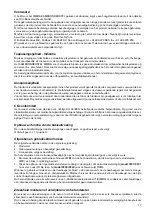
9
transferred from one to the other.
To remove the seating shell, step to the right of the seating shell (in driving direction) hold the back of the seat near the
head area with one hand. Now reach beneath the seat and pull the disengaging lever towards the footrest assembly
to release the seat attachment. Tilt the seat by slightly more that 45° to the rear and remove it by lifting upwards.
To remount the seat onto the mobility base, hold the seat as described above and first put the locking unit at an angle
of approximately 45° on the posterior tube of the seat adapter. Press the anterior seat edge onto the mobility base
until the seat audibly snaps in place. Make sure it’ s secure by giving it a few short jerks.
Possible adjustments and adaptations
Seat angle
After loosening the clamping lever (1/A) or (1/B)
, the seat support fixture can be adjusted in angle.
Seat height
The seat height can be adjusted off-load only. To do so, undo the clamping levers
(2/A)
as well as the additional stud
screws
(2/B)
and raise/lower the seat support fixture to the desired height.
( Height adjustment is restricted when the spring button locks
(2/C).
)
After that, firmly re-tighten all screw connections.
The clamping lever can, if pulled away from the screw a little, be moved off-load, thus enabling you to turn it
into a more convenient operating position.
Brakes
To activate the brakes, press the brake lever
(1/C)
downwards with the tip of your foot.
To release the brakes, pull the brake lever upwards with the tip of your foot.
Anti-tip bracket
The chassis must be lowered due to the increased risk of tipping when adjusting seat inclination. In order to lower
chassis, undo the stud screws
(2/E)
and pull out the rear frames (no further than the point at which the spring buttons
engage). Then firmly re-tighten the stud screws.
Pushbar
Facilitates pushing and maneuvering indoors.
After all adjustments, retighten the screw connections that have been loosened.
Practical notes on safety and care
➜
Please observe the maximum load capacity of 50 kg!
➜
Attaching heavy bags or similar may adversely affect stability.
➜
Never leave the patient unattended, not even when belts are in use and the brakes activated.
➜
After all adjustments, retighten any screw connections that have been loosened.
➜
Practice handling of chassis, seating system and patient before use.
➜
Clean all frame components and plastic parts using only standard household cleansing agents.
➜
Do not use in the sea ( salt water ); if at all possible, do not allow sand or other small particles to get into the
wheel bearings.
➜
Park the chassis with seat unit only with the wheel-lock system activated.
➜
Seat units must be mounted in travel direction.
➜
Before you adjust the tilt of the seat, always lower the rear frame tubing to the point where the spring
buttons engage.
Technical Data
Dimension (cms) and weights (kgs)
model 2231 / 2241
model 2233 / 2243
Lenght
62 - 78
62 - 78
Width
45
45
Height up to upper edge of seat
38 - 58
41 - 62
support fixture
(with wheel diameter 125 mm: +7 cm)
Tilt of seat support fxture
-10° up to +35°
-10° up to +25°
Additional load
50
50
Weight approx.
6,4 / 6,6
6,4 / 6,6
Summary of Contents for KIMBA 2231
Page 2: ...1 A 2 C B A B C F E D...






































